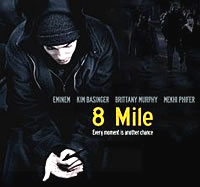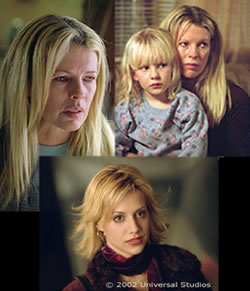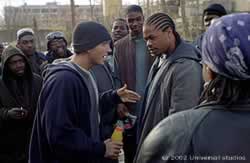8 Mile: Rap, Rabbit, Rap
By Loren Kajikawa
 8 Mile’s producer Brian Glazer has been credited with helping the likes of Ron Howard, Meg Ryan, Michael Keaton, and Tom Hanks achieve Hollywood success, but only time will tell whether or not he has yet another future movie star in his sights. Perhaps he has merely succeeded in cashing in on the biggest, most controversial pop star since Madonna. Even without regard for his future film prospects, however, there seems to be a general consensus that Eminem shines in 8 Mile, directed by Curtis Hanson (L.A. Confidential, 1998) and written by Scott Silver (johns, 1996 & Mod Squad, 1999). Love or hate him, like or detest rap, Americans of all colors, ages and musical persuasions have demonstrated their fascination with Eminem at the box office.
8 Mile’s producer Brian Glazer has been credited with helping the likes of Ron Howard, Meg Ryan, Michael Keaton, and Tom Hanks achieve Hollywood success, but only time will tell whether or not he has yet another future movie star in his sights. Perhaps he has merely succeeded in cashing in on the biggest, most controversial pop star since Madonna. Even without regard for his future film prospects, however, there seems to be a general consensus that Eminem shines in 8 Mile, directed by Curtis Hanson (L.A. Confidential, 1998) and written by Scott Silver (johns, 1996 & Mod Squad, 1999). Love or hate him, like or detest rap, Americans of all colors, ages and musical persuasions have demonstrated their fascination with Eminem at the box office.
8 Mile, named for the stretch of road separating poor, urban, black Detroit from its vanilla suburbs, chronicles the rise of John “Rabbit” Smith, Jr., a poor, white rapper trying to make a name for himself in the local hip-hop scene. Played by and based upon the life of rap superstar Eminem, Rabbit is a vessel of agitated emotions, always shaken to the point of exploding, and it is not hard to understand why. When we first meet him, he has just broken up with his girlfriend, lost his car, been embarrassed at a local rap club, and come home to his mother’s trailer to find her having sex with one of his high school acquaintances.
Rabbit’s reactions to such disappointments are uncannily honest and sometimes violent. He acts without thinking, like a short, brooding, hooded, baggy-pants-wearing id. One moment he beats his mother’s boyfriend to a pulp for insulting her. In the next, he plays the protective brother, consoling his young sister whom he loves more than anyone in the movie. The troubling aspect of Rabbit’s erratic behavior, however, is the pattern that emerges from it. He may show a patriarchal tenderness towards his practically mute sister, but the other main women in the film, his mother (Kim Bassinger) and girlfriend, Alex (Brittany Murphy) represent threats to Rabbit’s potency and require containment. But in contrast to Eminem’s rap alter-ego, Slim Shady, Rabbit never for a moment raises a fist in the direction of these women. Instead, he manages the threats they pose by attacking the men close to them.
brooding, hooded, baggy-pants-wearing id. One moment he beats his mother’s boyfriend to a pulp for insulting her. In the next, he plays the protective brother, consoling his young sister whom he loves more than anyone in the movie. The troubling aspect of Rabbit’s erratic behavior, however, is the pattern that emerges from it. He may show a patriarchal tenderness towards his practically mute sister, but the other main women in the film, his mother (Kim Bassinger) and girlfriend, Alex (Brittany Murphy) represent threats to Rabbit’s potency and require containment. But in contrast to Eminem’s rap alter-ego, Slim Shady, Rabbit never for a moment raises a fist in the direction of these women. Instead, he manages the threats they pose by attacking the men close to them.
The portrayal of these female characters is unapologetically problematic. Rabbit’s mother either sits around drunk, waiting for boyfriend Greg’s “settlement” check, or bets the family’s next meal at bingo, while Alex will do anything or anyone to climb towards her dream of becoming a model. Both characters need the help of others to survive, let alone put together a thought or two, and the film naturalizes their innate selfishness, as if their ontological essence were to impede Rabbit’s development. These women come off more as speedbumps, or sandtraps on a golf course than as people. In fact, the only female characters positively portrayed in 8 Mile are Lily, Rabbit’s little sister, and the female rappers, women who, coincidentally, are not cast as sexual agents.
Despite these flaws, Rabbit remains a captivating subject. Eminem seems comfortable, cool, and focused as the camera circles around him. His heart-breaking stares lend Rabbit a soft quality usually obscured by Eminem’s aggressive musical personae. That Rabbit sometimes cannot find the right words, that he occasionally stumbles, proves to be a satisfying and humanizing counterbalance to Eminem’s usual blitzkrieg of verbal virtuosity.
The dramatic tension of the movie rests in Rabbit’s growing confidence, the way he begins to use the shattered pieces of his life to create art. And we can all guess from the opening minutes of the movie what the resolution to this tension will be. More clues appear along the way as Rabbit unleashes bit by bit the same self-deprecating, angry mockery that made Eminem famous. Perversely, no matter what stance we have on Eminem’s lyrical content, we yearn for this release. We cheer for Rabbit to finally become Eminem, the one who can move the crowd, rocking the mic with his unrestrained diatribes. But 8 Mile makes us wait, like any other good story of perseverance and eventual triumph, until the climactic scene to see just exactly how he will do it. Drawing on the musical conventions of Rocky, another great-white-hope movie, we hear an “Eye of the Tiger”-like riff, which lets us know the big scene is on its way.
Along the way, Rabbit and his crew—all young black men, with the exception of the laughable, white Cheddar Bob—share some poignant and thought provoking moments against the gray/blue cinematography that captures the old brick buildings, rusted-out cars, and dark, dank hip-hop clubs of Detroit. Elegantly woven throughout these scenes, hip-hop music breathes life into the picture. Whether accompanying Rabbit on the bus in a state of soul-searching introspection or evoking the loneliness of a late night drive through the city, the soundtrack nearly exclusively uses hip-hop beats to lend emotional color to its scenes. Like other recent films, most notably Ghost Dog (1999), which featured a hip-hop soundtrack produced by RZA of Wu-Tang Clan, this approach marks a notable shift from scoring for old-school movies like Beat Street (1984) and Krush Groove (1985). In recent films, hip-hop underscores the dramatic moments of the film as well as the scenes in which rap is explicitly featured, demonstrating some of the different emotional textures that can be brought out through a medium whose detractors often dismiss as merely violent or aggressive.
Unfortunately, however, Shady/Interscope Record’s release of the CD, Music From and Inspired by the Motion Picture 8 Mile reflects a calculated marketing research play to cultivate new consumers. Instead of attempting to offer fans a CD that would recreate the sonic world of the film, this pseudo-soundtrack almost exclusively features cuts, whether used in the film or not, from artists on Eminem’s own label. Rather than paying even more royalties to other labels whose artists’ songs appear in the film, Shady/Interscope has developed a brilliant strategy to ride the coattails of 8 Mile.
Especially for people who care about rap music and hip-hop culture, the most compelling scenes in 8 Mile are the various freestyle “battles.” One such scene shows factory workers engaged in an impromptu cipher, a circle of rappers and onlookers taking turns trying to outdo one another. This battle becomes a brilliant re-appropriation of their painfully short 30-minute lunch break, but Rabbit’s defense of a gay coworker in this scene mars the illusion of authenticity. Strangely offensive in its own way (“Paul may be gay, but you’re a faggot”), Rabbit’s friendship with the film’s only gay character reads like a calculated public relations move and lets the steam out of an otherwise powerful moment.
the most compelling scenes in 8 Mile are the various freestyle “battles.” One such scene shows factory workers engaged in an impromptu cipher, a circle of rappers and onlookers taking turns trying to outdo one another. This battle becomes a brilliant re-appropriation of their painfully short 30-minute lunch break, but Rabbit’s defense of a gay coworker in this scene mars the illusion of authenticity. Strangely offensive in its own way (“Paul may be gay, but you’re a faggot”), Rabbit’s friendship with the film’s only gay character reads like a calculated public relations move and lets the steam out of an otherwise powerful moment.
This setback aside, the battle scenes illustrate the joy, jest, and pleasure in the most politically incorrect rapping. The rappers are practicing what Henry Louis Gates, Jr., has coined “signifyin’(g),” the African American art of wordplay that creates difference through repetition, subverting dominant narratives by foregrounding the slipperiness of language. The crux of such practices lies in the participants’ demonstration of their own imaginative vocal capacities, not necessarily in the quality of information being transmitted.
Although some might lament the fact that it has taken a movie about a white rapper to make such a compelling statement about African American culture, the movie itself seems poised to counter such race-thinking. One of the most important, though implicit, suggestions made by 8 Mile is that to this generation, boundaries of culture and class are much more important than those of race. In one of the funniest and most memorable scenes, Rabbit and Future (Mekhi Phifer) do an impromptu rap revision of Lynyrd Skynyrd’s “Sweet Home Alabama,” heard playing from Rabbit’s mother’s trailer. The refrain “Sweet Home Alabama” becomes “I live at home in a trailer,” and by signifying on this rock ‘n’ roll classic, Rabbit both finds a way to deal with the desperation of his situation and illustrate that although he is white, his point of identification lies with Future and their crew.
Writing for the New Yorker, David Denby asserts that in 8 Mile, “Race is an issue, but it’s not the most important issue. The universal appreciation of talent matters more … Fair is fair: the man [Rabbit/Eminem] can do it” (196). While I agree that 8 Mile propagates this message, there still remains the need to calculate the price exacted by this erasure of race. The permeability of racial boundaries and subtlety of interracial bonds in 8 Mile are without question refreshing and positive. At the same time, one cannot help but imagine the appropriation of these tropes to serve a racist ideology that positions white males as the victims of alleged black privilege gained through affirmative action. A fan, posting an enthusiastic response to an “ifilm” review of 8 Mile, bears testimony to such anxieties:
This movie was OUTSTANDING! I love how it showed the struggle of a young white male trying to make it in a black industry. All he went through…The movie really is a must see for anyone who can appreciate someone who had to fight for what they have and for someone with undying will to get what he or she wants. (“Eminem is a Genius”)
This viewer unwittingly picks up on the way in which the storyline of 8 Mile and biography of Eminem intersect with neo-conservative rhetoric about race. For example, she praises the movie for foregrounding Eminem’s strength of will and work ethic, and coincidentally Rabbit is the only character in his crew who seems to possess the motivation to move beyond the small world of urban Detroit. She also takes pleasure in seeing Rabbit succeed in a black cultural world, a pleasure that betrays what could represent for some the soothing reassertion of white privilege in a cultural arena previously off limits. Most problematic of all, the suggestion that Eminem operates in a “black industry,” while laughable, reveals the extent to which people buy into narratives of how the white American male has been disenfranchised. 8 Mile opens itself to such a reading by keeping its sights set on the inner-city, avoiding any suggestion that hip-hop music circulates through the conduits of multinational capitalism and is heavily dependent on suburban, white teenagers for its revenues.
In the movie itself, just like the neo-conservative rhetoric that naively calls for a “colorblind” society, Rabbit uses his class identity to pivot around problematic racial relationships. Thus, the film’s climactic scene hinges on Rabbit finally embracing his “white trash” background, turning it against an “inauthentic” bourgeois black foe. In a genre where overcoming adversity and “keeping it real” are selling points, Rabbit uses his status as “white trash” to locate himself as the ultimate victim, flipping the conventional logic of race hierarchy on its head. While recognizing class and/or cultural identities deconstructs the illogic of racism, 8 Mile ignores what will happen after Rabbit gains the respect of his peers, leaving them to join the mass mediated machinery that gave birth to Eminem and to the movie 8 Mile itself. The fact remains that Eminem’s whiteness sells a lot of records. It explains why so many thirteen year-old white kids claim they don’t like rap, but love Eminem. His place in the American racial imagination has helped make him rich.
In some ways, the Rabbit of 8 Mile represents the Rabbit of John Updike’s series rearticulated for the new millennium. (This connection is made by the 8 Mile soundtrack, which contains an original Eminem tune entitled “Rabbit Run”—the title of Updike’s first book.) He’s the white everyman of his generation, except that his everyman status relies on his uniqueness instead of his plainness. As “white trash,” Eminem has a proximity to and an “authentic” relationship with inner city black rappers, something tangible that middle-American voyeurs can exploit to share his bond with and mastery of a perceived hostile black territory.
Whether or not the literary reference was intentional, both Rabbits represent middle-American constituencies confronting racialized economic and cultural anxieties. Both are cast as losers that respond emotionally and unapologetically to the circumstances they find themselves in, voicing their pain in politically incorrect language. Both are anti-heroes that engender an uncomfortable sympathy: We cheer for them to break free of their cages while worrying that they may be doing more damage than good. And both are white men in the middle of a multicultural American landscape, which threatens to swallow them whole if they cannot find some way to hold on to their role as protagonists.
8 Mile extends the possibility of both promising and problematic human relationships. It demonstrates how class and cultural identities often determine opportunities and allegiances, but obscures how race continues to distribute the rewards of hard work—money and respect—unevenly. While 8 Mile remains open to a number of problematic readings, perhaps the blame lies less with Eminem than with our society’s apparent readiness to use him to support neo-conservative attitudes about race. In this case, Eminem’s refrain, “I am whatever you say I am. If I wasn’t then why would I say am?” seems absolutely axiomatic.
Loren Kajikawa
University of California, Los Angeles
Works Cited
Denby, David. “Breaking Through: 8 Mile and Frida.” The New Yorker 78.34 (11 November 2002): 195–197.
Tigerladyip. “Eminem Is a Genius.” Online posting. ifilm: The Internet Movie Guide. Accessed 16 November 2002 http://www.ifilm.com/ifilm/product/film_info/0,3699,2450860,00.html.
Beat Street. Dirs. Stan Lathan and Wynn P. Thomas. Orion, 1984.
Krush Groove. Dir. Michael Shultz. Warner Brothers, 1985.
Ghost Dog. Dir. Jim Jarmusch. Artisan, 1999.
